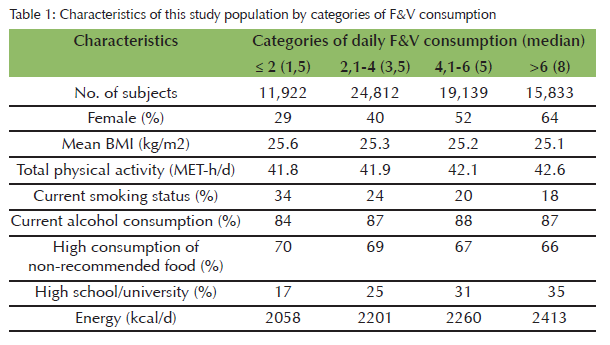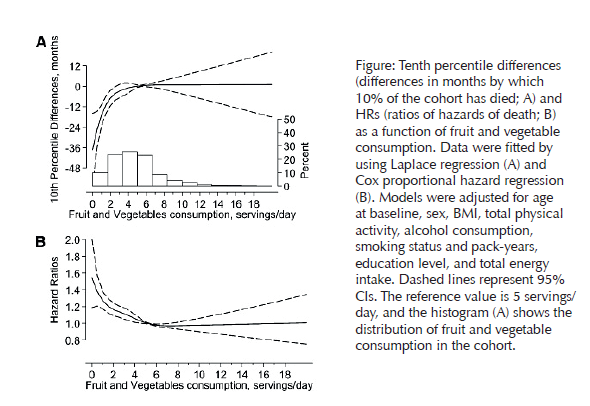Eating fruit and vegetables daily and living longer
It was found that daily consumption of fruit and vegetables (F&V) was associated with a substantially longer survival and lower rate of overall mortality.
This study was conducted in a large cohort of Swedish population from 1998 to 2010, with the aim to examine the dose-response relation between F&V consumption and mortality, in terms of both time to death and mortality rate.
F&V consumption was assessed through a self-administrated questionnaire in a population-based cohort of 71,706 participants aged 45–83 years, from the population-based Cohort of Swedish Men and the Swedish Mammography Cohort. Information on F&V consumption was collected by using 14 questions on vegetables (carrot, beetroot, lettuce, cabbage, caulifl ower, broccoli, tomato, pepper, spinach, peas, onion, garlic, and other vegetables), fi ve questions on fruit (orange, apple, banana, berry, and other fruit), and one question on orange juice. Participants were asked to indicate how often on average in the previous year they had consumed each food. Our main variables for F&V, fruit, and vegetable consumption were calculated as the average servings per day and were obtained by converting the questionnaire responses to average daily intake of each item and adding the intake of all items.
During 13 years of follow-up, 16% of deaths occurred (11,439 deaths). Therefore, the analysis was focused on the 10th percentile of survival, expressed in months, that being the time by which 10% of participants in the current study died.
Characteristics of the study population by categories of F&V consumption (Table1)
- On average, women tended to consume more F&V than did men.
- Participants with a low F&V intake were more likely :
- to be current smokers,
- to have a lower educational level,
- to have a higher consumption of non-recommended foods.
- An increase in F&V consumption corresponded to a higher total energy intake.
- Age, BMI, physical activity, and alcohol consumption were similar, overall, across categories of FV consumption. The overall 10th survival percentile was 116 months, which meant that 90% of the cohort was still alive after 9.6 years of follow-up.

People consuming fi ve or more servings of F&V lived longer than those who ate less
Compared with an F&V consumption of five servings/day, lower levels of consumption were progressively associated with shorter survival up to three years for those who never consumed F&V daily. The mortality rate for those who did not consume F&Vs was 53% higher than the rate for those who consumed the recommended dose of fi ve servings/day. Compared with an F&V consumption of fi ve servings/day, higher levels of consumption were not associated with longer survival or a decreased rate of mortality.

Benefi ts from eating fruit were observed at a consumption of merely one serving/day, whereas vegetable consumption was associated with a progressively longer survival up to three servings/day. People who never consumed fruit lived 19 months less than those who consumed one fruit per day. Participants who consumed three vegetables a day lived 32 months longer than those who ate no vegetables.
The study next evaluated possible interactions between F&V and sex, smoking status, BMI, and education level in predicting mortality. The shape of the dose-response relation between F&V and the 10th survival percentile did not substantially change according to sex (P-interaction = 0.31), smoking status (P-interaction = 0.53), BMI (P-interaction = 0.82), and education level (P-interaction = 0.35).
Based on: Bellavia A, Larsson SC, Bottai M, Wolk A, Orsini N.Am. Fruit and vegetable consumption and all-cause mortality: a dose-response analysis. J Clin Nutr..June 2013
